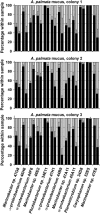Signaling-mediated cross-talk modulates swarming and biofilm formation in a coral pathogen Serratia marcescens
- PMID: 21509042
- PMCID: PMC3176518
- DOI: 10.1038/ismej.2011.45
Signaling-mediated cross-talk modulates swarming and biofilm formation in a coral pathogen Serratia marcescens
Abstract
Interactions within microbial communities associated with marine holobionts contribute importantly to the health of these symbiotic organisms formed by invertebrates, dinoflagellates and bacteria. However, mechanisms that control invertebrate-associated microbiota are not yet fully understood. Hydrophobic compounds that were isolated from surfaces of asymptomatic corals inhibited biofilm formation by the white pox pathogen Serratia marcescens PDL100, indicating that signals capable of affecting the associated microbiota are produced in situ. However, neither the origin nor structures of these signals are currently known. A functional survey of bacteria recovered from coral mucus and from cultures of the dinoflagellate Symbiodinium spp. revealed that they could alter swarming and biofilm formation in S. marcescens. As swarming and biofilm formation are inversely regulated, the ability of some native α-proteobacteria to affect both behaviors suggests that the α-proteobacterial signal(s) target a global regulatory switch controlling the behaviors in the pathogen. Isolates of Marinobacter sp. inhibited both biofilm formation and swarming in S. marcescens PDL100, without affecting growth of the coral pathogen, indicative of the production of multiple inhibitors, likely targeting lower level regulatory genes or functions. A multi-species cocktail containing these strains inhibited progression of a disease caused by S. marcescens in a model polyp Aiptasia pallida. An α-proteobacterial isolate 44B9 had a similar effect. Even though ∼4% of native holobiont-associated bacteria produced compounds capable of triggering responses in well-characterized N-acyl homoserine lactone (AHL) biosensors, there was no strong correlation between the production of AHL-like signals and disruption of biofilms or swarming in S. marcescens.
Figures





Similar articles
-
Characterization of the gacA-dependent surface and coral mucus colonization by an opportunistic coral pathogen Serratia marcescens PDL100.FEMS Microbiol Ecol. 2013 May;84(2):290-301. doi: 10.1111/1574-6941.12064. Epub 2013 Jan 14. FEMS Microbiol Ecol. 2013. PMID: 23278392
-
Utilization of mucus from the coral Acropora palmata by the pathogen Serratia marcescens and by environmental and coral commensal bacteria.Appl Environ Microbiol. 2009 Jun;75(12):3851-8. doi: 10.1128/AEM.00457-09. Epub 2009 Apr 24. Appl Environ Microbiol. 2009. PMID: 19395569 Free PMC article.
-
Members of native coral microbiota inhibit glycosidases and thwart colonization of coral mucus by an opportunistic pathogen.ISME J. 2013 May;7(5):980-90. doi: 10.1038/ismej.2012.164. Epub 2012 Dec 20. ISME J. 2013. PMID: 23254513 Free PMC article.
-
Quorum sensing in Serratia.FEMS Microbiol Rev. 2007 Jul;31(4):407-24. doi: 10.1111/j.1574-6976.2007.00071.x. Epub 2007 Apr 25. FEMS Microbiol Rev. 2007. PMID: 17459113 Review.
-
Quorum sensing of bacteria and trans-kingdom interactions of N-acyl homoserine lactones with eukaryotes.J Chem Ecol. 2012 Jun;38(6):704-13. doi: 10.1007/s10886-012-0141-7. Epub 2012 May 31. J Chem Ecol. 2012. PMID: 22648507 Review.
Cited by
-
Response and Adaptation of Microbial Community in a CANON Reactor Exposed to an Extreme Alkaline Shock.Archaea. 2020 Jun 23;2020:8888615. doi: 10.1155/2020/8888615. eCollection 2020. Archaea. 2020. PMID: 32694931 Free PMC article.
-
The Role of Complement in Cnidarian-Dinoflagellate Symbiosis and Immune Challenge in the Sea Anemone Aiptasia pallida.Front Microbiol. 2016 Apr 22;7:519. doi: 10.3389/fmicb.2016.00519. eCollection 2016. Front Microbiol. 2016. PMID: 27148208 Free PMC article.
-
Variability in microbial community composition and function between different niches within a coral reef.Microb Ecol. 2014 Apr;67(3):540-52. doi: 10.1007/s00248-013-0362-5. Epub 2014 Jan 30. Microb Ecol. 2014. PMID: 24477921
-
Quorum sensing signal production and microbial interactions in a polymicrobial disease of corals and the coral surface mucopolysaccharide layer.PLoS One. 2014 Sep 30;9(9):e108541. doi: 10.1371/journal.pone.0108541. eCollection 2014. PLoS One. 2014. PMID: 25268348 Free PMC article.
-
Marine Bacterial Secondary Metabolites: A Treasure House for Structurally Unique and Effective Antimicrobial Compounds.Mar Drugs. 2021 Sep 23;19(10):530. doi: 10.3390/md19100530. Mar Drugs. 2021. PMID: 34677431 Free PMC article. Review.
References
-
- Alagely A, Rajamani S, Teplitski M. Luminescent reporters and their applications for the characterization of signals and signal-mimics that alter LasR-mediated quorum sensing. Method Mol Biol. 2011;692:113–130. - PubMed
-
- Bourne D, Iida Y, Uthicke S, Smith-Keune C. Changes in coral-associated microbial communities during a bleaching event. ISME J. 2008;2:350–363. - PubMed
-
- Brown BE, Bythell JC. Perspectives on mucus secretion in reef corals. Mar Ecol Progr Series. 2005;296:291–309.
-
- Cha C, Gao P, Chen YC, Shaw PD, Farrand SK. Production of acyl-homoserine lactone quorum-sensing signals by gram-negative plant-associated bacteria. Mol Plant Microbe Interact. 1998;11:1119–1129. - PubMed
Publication types
MeSH terms
Substances
LinkOut - more resources
Full Text Sources
Other Literature Sources
Molecular Biology Databases
Research Materials
Miscellaneous

